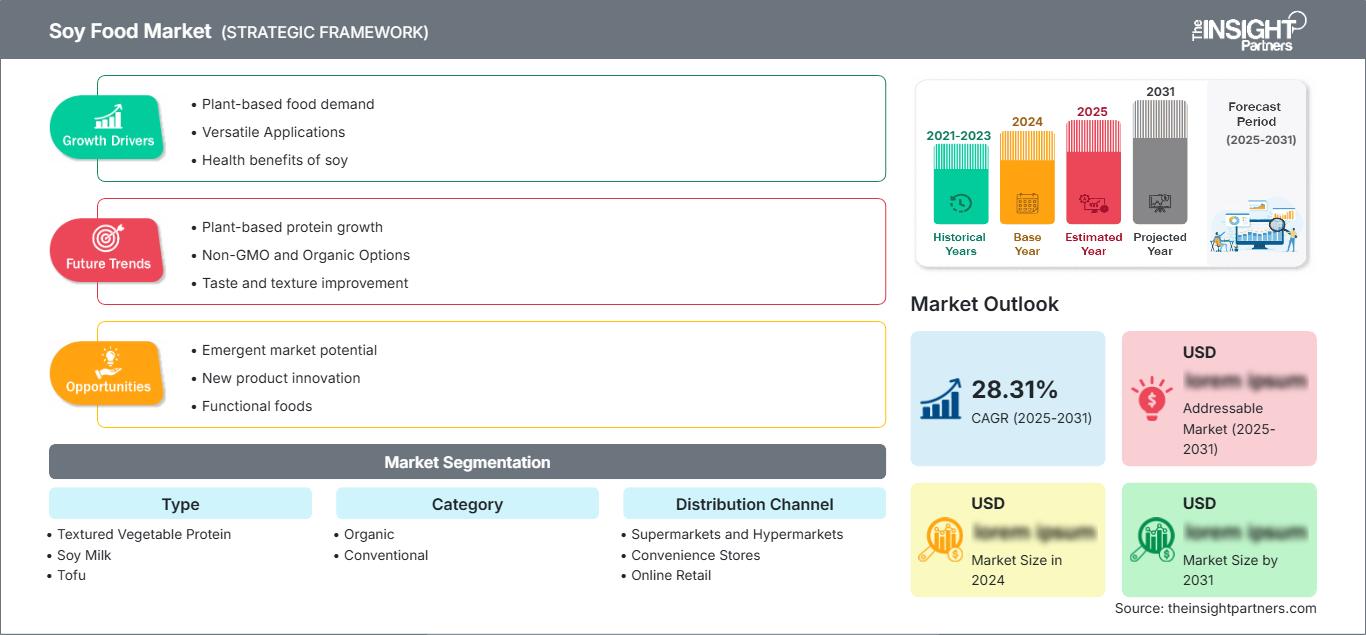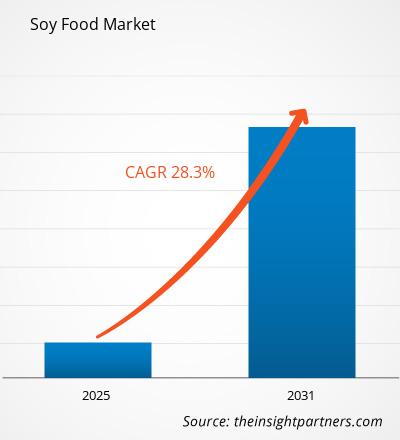Der Markt für Sojalebensmittel wird voraussichtlich zwischen 2025 und 2031 eine durchschnittliche jährliche Wachstumsrate (CAGR) von 28,31 % verzeichnen, wobei sich das Marktvolumen von XX Millionen US-Dollar im Jahr 2024 auf XX Millionen US-Dollar im Jahr 2031 erhöht.
Der Markt für Sojalebensmittel ist nach Typ in die folgenden Untersegmente unterteilt: Texturiertes Pflanzenprotein (TVP), Sojamilch, Tofu, Sojaöl und Sonstiges. Darüber hinaus wird eine Analyse nach Kategorie (biologisch, konventionell) und Vertriebskanal (Supermärkte und Hypermärkte, Convenience Stores, Online-Einzelhandel und Sonstiges) präsentiert. Die globale Analyse ist auf regionaler Ebene und nach den wichtigsten Ländern aufgeschlüsselt. Die Marktbewertung wird für die obige Segmentanalyse in US-Dollar angegeben.
Zweck des Berichts
Der Bericht „Sojalebensmittelmarkt“ von The Insight Partners soll die aktuelle Situation und das zukünftige Wachstum sowie die wichtigsten treibenden Faktoren, Herausforderungen und Chancen beschreiben. Dadurch erhalten verschiedene Geschäftsinteressenten Einblicke, beispielsweise:
- Technologieanbieter/-hersteller: Um die sich entwickelnde Marktdynamik zu verstehen und die potenziellen Wachstumschancen zu kennen, sodass sie fundierte strategische Entscheidungen treffen können.
- Investoren: Um eine umfassende Trendanalyse hinsichtlich der Marktwachstumsrate, der finanziellen Marktprognosen und der Chancen entlang der Wertschöpfungskette durchzuführen.
- Regulierungsbehörden: Um Richtlinien und Überwachungsaktivitäten auf dem Markt zu regulieren, mit dem Ziel, Missbrauch zu minimieren, das Vertrauen der Investoren zu wahren und die Integrität und Stabilität des Marktes aufrechtzuerhalten.
Marktsegmentierung für Sojalebensmittel: Typ
- Texturiertes Pflanzenprotein
- Sojamilch
- Tofu
- Sojaöl
- Sonstige
Kategorie
- Bio
- Konventionell
Vertriebskanal
- Supermärkte und Hypermärkte
- Convenience Stores
- Online-Einzelhandel
- Sonstige
Geografie
- Nordamerika
- Europa
- Asien-Pazifik
- Süd- und Mittelamerika
- Naher Osten und Afrika
Sie erhalten kostenlos Anpassungen an jedem Bericht, einschließlich Teilen dieses Berichts oder einer Analyse auf Länderebene, eines Excel-Datenpakets sowie tolle Angebote und Rabatte für Start-ups und Universitäten.
Soja-Lebensmittelmarkt: Strategische Einblicke

-
Holen Sie sich die wichtigsten Markttrends aus diesem Bericht.Dieses KOSTENLOSE Beispiel umfasst Datenanalysen, die von Markttrends bis hin zu Schätzungen und Prognosen reichen.
Wachstumstreiber für den Soja-Lebensmittelmarkt
- Nachfrage nach pflanzlichen Lebensmitteln: Produkte wie Sojamilch, Tofu und Tempeh erfreuen sich aufgrund der zunehmenden Beliebtheit veganer, vegetarischer und flexitarischer Ernährungsweisen in letzter Zeit als pflanzliche Proteinalternativen großer Beliebtheit.
- Vielseitige Anwendungsmöglichkeiten: Soja wird in einer breiten Palette von Produkten verwendet, von Milchersatzprodukten über Sojakäse und Joghurt bis hin zu Fleischersatzprodukten, die ein breites Marktangebot abdecken.
- Gesundheitliche Vorteile von Soja: Soja enthält hochwertiges Protein und ist reich an Isoflavonen, die die Herzgesundheit unterstützen und das potenzielle Risiko bestimmter Krebsarten senken können, was Soja zu einer gesundheitsbewussten Wahl in der Nahrungskette macht.
Zukünftige Trends im Soja-Lebensmittelmarkt
- Wachstum bei pflanzlichen Proteinen: Der Trend hin zu pflanzlichen Proteinen führt zur Entwicklung von Sojaprodukten bis hin zu Sojaburgern mit nahezu fleischähnlicher Textur und Geschmack und Würstchen usw.
- GVO-freie und Bio-Optionen: Die Nachfrage der Verbraucher nach GVO-freien und Bio-Lebensmitteln veranlasst die Hersteller, mehr Sojaprodukte zu entwickeln, die den Vorlieben der Verbraucher entsprechen.
- Verbesserung von Geschmack und Textur: Innovationen bei der Rezeptur von Sojaprodukten sorgen dafür, dass diese mehr wie Produkte tierischen Ursprungs schmecken und sich auch so anfühlen, was sie auch für Nicht-Veganer attraktiver macht.
Marktchancen für Sojalebensmittel
- Neues Marktpotenzial: Da sich Gesundheitstrends und Ernährungspräferenzen weltweit ändern, wird Soja in Märkten in Asien, Lateinamerika und sogar Teilen Afrikas zunehmend als Teil ihrer Ernährung akzeptiert.
- Neue Produktinnovationen: Dazu gehört die Möglichkeit, neue Produkte auf Sojabasis zu entwickeln, um dem sich ändernden Geschmack der Verbraucher gerecht zu werden; am häufigsten sind Snacks, Getränke und Desserts auf Sojabasis.
- Funktionale Lebensmittel: Soja kann zusätzliche Nährstoffe wie Omega-3 oder Probiotika enthalten und erobert so den immer beliebter werdenden Markt für funktionelle Lebensmittel.
Markt für Sojalebensmittel
Die Analysten von The Insight Partners haben die regionalen Trends und Faktoren, die den Soja-Lebensmittelmarkt im Prognosezeitraum beeinflussen, ausführlich erläutert. In diesem Abschnitt werden auch die Marktsegmente und die geografische Lage in Nordamerika, Europa, dem asiatisch-pazifischen Raum, dem Nahen Osten und Afrika sowie Süd- und Mittelamerika erörtert.Umfang des Soja-Lebensmittelmarktberichts
| Berichtsattribut | Einzelheiten |
|---|---|
| Marktgröße in 2024 | US$ XX million |
| Marktgröße nach 2031 | US$ XX Million |
| Globale CAGR (2025 - 2031) | 28.31% |
| Historische Daten | 2021-2023 |
| Prognosezeitraum | 2025-2031 |
| Abgedeckte Segmente |
By Typ
|
| Abgedeckte Regionen und Länder |
Nordamerika
|
| Marktführer und wichtige Unternehmensprofile |
|
Dichte der Akteure auf dem Soja-Lebensmittelmarkt: Verständnis ihrer Auswirkungen auf die Geschäftsdynamik
Der Markt für Sojaprodukte wächst rasant. Die steigende Nachfrage der Endverbraucher ist auf Faktoren wie veränderte Verbraucherpräferenzen, technologische Fortschritte und ein stärkeres Bewusstsein für die Produktvorteile zurückzuführen. Mit der steigenden Nachfrage erweitern Unternehmen ihr Angebot, entwickeln Innovationen, um den Bedürfnissen der Verbraucher gerecht zu werden, und nutzen neue Trends, was das Marktwachstum weiter ankurbelt.

- Holen Sie sich die Soja-Lebensmittelmarkt Übersicht der wichtigsten Akteure
Wichtige Verkaufsargumente
- Umfassende Abdeckung: Der Bericht analysiert umfassend Produkte, Dienstleistungen, Typen und Endnutzer des Soja-Lebensmittelmarkts und bietet einen ganzheitlichen Überblick.
- Expertenanalyse: Der Bericht basiert auf dem umfassenden Verständnis von Branchenexperten und Analysten.
- Aktuelle Informationen: Der Bericht gewährleistet Geschäftsrelevanz durch die Berichterstattung über aktuelle Informationen und Datentrends.
- Anpassungsoptionen: Dieser Bericht kann an spezifische Kundenanforderungen angepasst werden und passt sich den Geschäftsstrategien optimal an.
Der Forschungsbericht zum Soja-Lebensmittelmarkt kann daher dabei helfen, die Branchensituation und die Wachstumsaussichten zu entschlüsseln und zu verstehen. Obwohl es einige berechtigte Bedenken geben mag, überwiegen die Vorteile dieses Berichts tendenziell die Nachteile.
- Historische Analyse (2 Jahre), Basisjahr, Prognose (7 Jahre) mit CAGR
- PEST- und SWOT-Analyse
- Marktgröße Wert/Volumen – Global, Regional, Land
- Branchen- und Wettbewerbslandschaft
- Excel-Datensatz
Aktuelle Berichte
Verwandte Berichte
Erfahrungsberichte
Grund zum Kauf
- Fundierte Entscheidungsfindung
- Marktdynamik verstehen
- Wettbewerbsanalyse
- Kundeneinblicke
- Marktprognosen
- Risikominimierung
- Strategische Planung
- Investitionsbegründung
- Identifizierung neuer Märkte
- Verbesserung von Marketingstrategien
- Steigerung der Betriebseffizienz
- Anpassung an regulatorische Trends






















 Kostenlose Probe anfordern für - Soja-Lebensmittelmarkt
Kostenlose Probe anfordern für - Soja-Lebensmittelmarkt